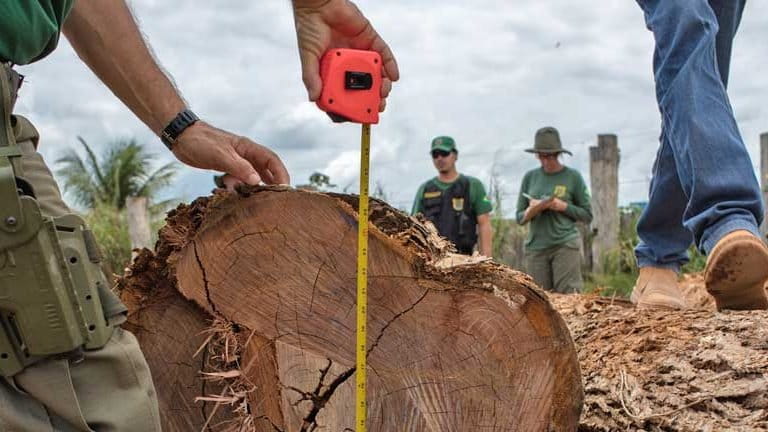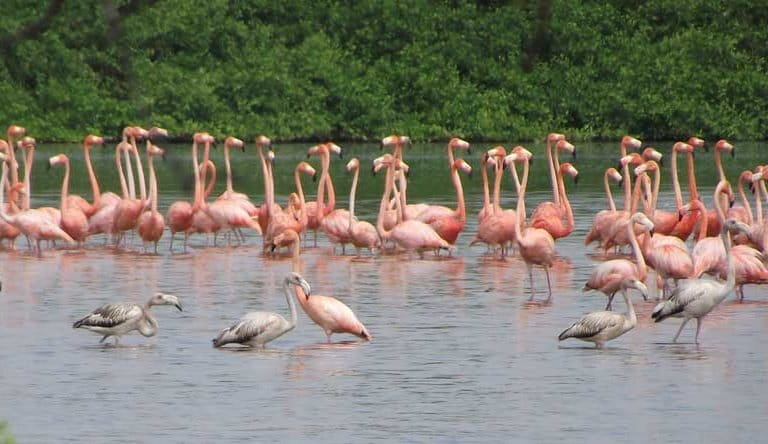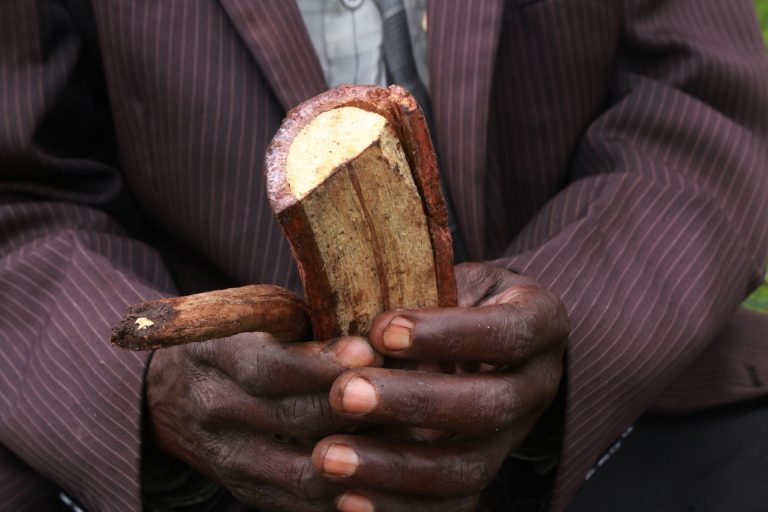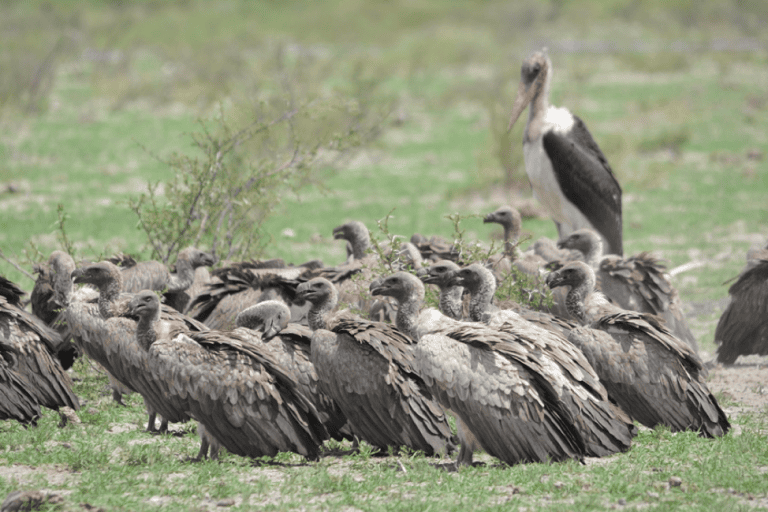FEATURED
Illegal loggers ‘cook the books’ to harvest Amazon’s most valuable tree by Jenny Gonzales [05/24/2018]
 |
– A new study finds that illegal logging, coupled with weak state-run timber licensing systems, has led to massive timber harvesting fraud in Brazil, resulting in huge illicit harvests of Ipê trees. This process is doing major damage to the Amazon, as loggers build roads deep into forests, causing fragmentation and creating greater access.
– To reduce document fraud, the Brazilian federal government this month required that all states register or integrate their timber licensing systems within a national timber inventory and tracking system known as Sinaflor. While this should reduce fraudulent paperwork, onsite illicit timber harvesting practices remain a major problem.
– Better oversight of forest management plans and more onsite inspections of timber operations are needed to curb illegal logging practices and to prevent harvesting on public lands and in indigenous reserves. The high value of Ipê wood — selling for up to $2,500 per cubic meter at export — makes it very profitable for illegal loggers.
– Ipê wood is largely shipped to the U.S. and Europe. Analysts say that buyers all along the timber supply chain turn a blind eye toward fraud, with sawmills, exporters, and importers trusting the paperwork they receive, rather than questioning whether the lower prices they pay for Ipê and other timber may be due to timber laundering.
Agroforestry gives Kenyan indigenous community a lifeline by Sophie Mbugua [05/24/2018]
– The Cherangani people of Kenya were for generations reliant on the forest for hunting, gathering and agroforestry — a way of life that was curtailed by the colonial government.
– Today, Cherangani communities living on the edge of the forest have returned to their traditions, intercropping avocado, bean and coffee plants among trees that help reduce water runoff and soil erosion, and improve nutrient cycling.
– The return to agroforestry has had wide-ranging benefits, from helping the communities improve their livelihoods, to minimizing human-animal conflicts by providing a buffer of fruit trees between the farms and forest.
– The project has received $5 million in funding, which is expected to provide training to more than 2,000 households on forest conservation and agroforestry techniques.
In unsuspecting Indian villages, the international rhino horn trade takes a toll by Moushumi Basu [05/22/2018]
– The vast majority of villagers around India’s Jaldapara National Park live in harmony with the area’s wildlife, but a small minority get involved in rhino poaching.
– Experts and former poachers say villagers are recruited by organized poaching syndicates. Locals serve as guides and lookouts, while syndicates arrange for the transport and sale of rhino horns.
– From West Bengal, rhino horns are taken to India’s northeastern states and then across the border to Myanmar and eventually to China.
African vultures under the gun as lead ammunition takes a toll by Jim Tan [05/22/2018]
– Fragments of lead ammunition in abandoned animal carcasses may be poisoning Africa’s vultures, a new study has found.
– Researchers found elevated blood lead levels among vultures in hunting areas and during hunting season in Botswana.
– This study adds to the growing evidence from around the world that identifies lead ammunition as a problem for a number of bird species.
– South African hunters are sympathetic to vultures but oppose a total ban on lead ammunition, citing the cost and availability of lead-free alternatives.
Venezuela’s hungry hunt wildlife, zoo animals, as economic crisis grows by Jeanfreddy Gutiérrez Torres [05/21/2018]
 |
– Venezuela is suffering a disastrous economic crisis. With inflation expected to hit 13,000 percent in 2018, there has been a collapse of agricultural productivity, commercial transportation and other services, which has resulted in severe food shortages. As people starve, they are increasingly hunting wildlife, and sometimes zoo animals.
– Reports from the nation’s zoos say that animals are emaciated, with keepers sometimes forced to feed one form of wildlife to another, just to keep some animals alive. There have also been reports of mammals and birds being stolen from zoo collections. Zoos have reached out to Venezuelans, seeking donations to help feed their wild animals.
– The economic crisis makes scientific data gathering difficult, but a significant uptick in the harvesting of Guiana dolphin, known locally as tonina, has been observed. The dolphin is protected from commercial trade under the Convention on International Trade in Endangered Species of Wild Fauna and Flora (CITES).
– The grisly remains of hunted pink flamingos have been found repeatedly on Lake Maracaibo. Also within the estuary, there has also been a rise in the harvesting of sea turtle species, including the vulnerable leatherback (Dermochelys coriacea), and the critically endangered hawksbill (Eretmochelys imbricata).
Brazil has the tools to end Amazon deforestation now: report by Giovanni Ortolani [05/18/2018]
 |
– A coalition of environmental NGOs known as the Zero Deforestation Working Group has developed a practical plan called “A Pathway to Zero Deforestation in the Amazon.” First proposed at the COP23 climate summit in Bonn, Germany, last November, the NGOs propose workable strategies for ending deforestation quickly in Brazil, while also yielding significant economic and social benefits.
– Deforestation continues, the report says, because cleared land is worth more than forested land in the Amazon, so there is a strong economic incentive to buy up large amounts of forestland and clear it. Also, enforcement of Brazilian forestry laws remains weak. Finally, markets have been slow to make, and implement, commitments to remove deforestation from their supply chains.
– Deforestation solutions require a new development vision for the Brazilian Amazon, say analysts, with policies that promote the sustainable use of forest products, and policies that end the expansion of agro-commodities into native forests, and promote agribusiness growth on the nation’s surplus of 15-20 million hectares of already deforested and degraded land.
– Law enforcement to curb illegal land grabbing also needs to happen, especially on the 70 million hectares of public land in Amazonia not allocated for specific uses. Also, government must start tracking cattle from point of origin with indirect suppliers, where deforestation occurs, to slaughterhouses. A key step to a solution: open talks between agribusiness and environmentalists.
NEWS
Guardians of India’s rhinos find it takes a village to fight poachers by Moushumi Basu [05/24/2018]
– Adjacent to an international border and with roads, a rail line and tea plantations within its boundaries, India’s Jaldapara National Park — home to more than 200 rhinos — is particularly vulnerable to poaching.
– The forest department works closely with local residents to protect rhinos, and 40 percent of tourist revenues are earmarked to support community projects.
– Forest department strategies range from rehabilitation of confessed poachers to joint exercises with the police and border patrol.
Chinese giant salamander is at least five species — all nearly extinct by Shreya Dasgupta [05/24/2018]
– Scientists who spent four years surveying the Chinese giant salamander’s preferred river habitats across 97 counties in China spotted only 24 individuals at four sites.
– None of the 24 individuals were “pure natural forms,” the researchers found, and were likely farm releases or escapees.
– The Chinese giant salamander also represents not one but at least five different species-level lineages. However, the large extent of hybridization in these animals through farming could mean that these distinct lineages are already functionally extinct.
Rangers face a ‘toxic mix’ of mental strain and lack of support by Jim Tan [05/24/2018]
– Wildlife rangers are facing numerous psychological pressures leading to potentially serious mental health implications.
– Rangers tackling wildlife crime and defending natural habitats in parts of Africa and Asia are frequently subjected to violent confrontations inside and outside their work.
– Many rangers see their families as little as once a year, causing immense stress to personal relationships.
– There is currently very little awareness of the mental strain placed on rangers, and a dearth of research into the potential mental health issues they face.
Making the most of conservation science (commentary) by Claire Wordley [05/23/2018]
– Increasing numbers of scientific papers on conservation are published every year, but for many people these remain inaccessible behind paywalls, difficult to locate in a vast ocean of research, or time-consuming to read.
– There are increasing attempts to bring the evidence for particular questions together in digestible formats, such as systematic reviews or Mongabay’s Conservation Effectiveness series. One such enterprise is the Conservation Evidence project, which assesses the evidence for the effectiveness of conservation interventions.
– A new edition of the book ‘What Works in Conservation,’ produced by Conservation Evidence, is available and free to download. This book helps us to see which conservation interventions have been shown to work, which have been shown not to work, and where we need more evidence.
– This post is a commentary. The views expressed are those of the author, not necessarily Mongabay.
Hunters are wiping out hornbills in Ghana’s forests by John C. Cannon [05/23/2018]
– According to a new study, Ghana is losing hornbill species to “uncontrolled” hunting, mostly for meat, from its forested parks and reserves.
– The researchers found that the five largest species of hornbills in the Bia Biosphere Reserve, a UNESCO World Heritage Site, have disappeared in recent decades.
– The authors of the paper suggest that increased enforcement will help protect threatened hornbills, as well as other wildlife species, in areas under intense pressure from humans.
Trio of studies challenges Indian government claim of increasing forest cover by T. V. Padma [05/23/2018]
– Three studies published over the past seven months show that forest cover in India is declining, contrary to findings from the latest Forest Survey of India report.
– One study found 16 to 30 percent forest loss in the eastern Himalayan state of Sikkim, while another study found that the Eastern Ghats lost nearly 16 percent of their forest area between 1920 and 2015.
– The third study, which analyzed patterns of forest cover across India from 2001 to 2014, found “significant negative changes” in the seasonal green cover, with the highest decline recorded in tropical moist deciduous forests.
Roads might pose even bigger threat to Southeast Asian forests, biodiversity than previously understood by Mike Gaworecki [05/22/2018]
– According to Alice Hughes, a researcher with the Chinese Academy of Sciences’ Centre for Integrative Conservation, global analyses often underestimate levels of deforestation driven by road-building in the Indo-Malaysia region. This is because many of those analyses rely on a widely used global map of roads compiled by Open Street Maps (OSM) that misses as much as 99 percent of roads in parts of the region.
– According to Hughes, this level of inaccuracy can have serious consequences: “Not only does it mean that any analysis based on global roads datasets will underestimate the level of fragmentation and overestimate the forest coverage of a region, but most forms of exploitation also occur within close proximity to a road.”
– Increasing deforestation is not the only threat posed by opening new areas to roads. “These growing road networks provide accessibility for other forms of resource exploitation,” Hughes notes in the study. “Most notably this includes selective logging, and hunting, which in the Indo-Malay region also targets a vast suite of species as pets, medicine and meat.”
Fishing gear poses the greatest danger to young great whites off the West Coast of the U.S. by John C. Cannon [05/22/2018]
– Fishing lines and nets pose the most significant threat to the survival of young white sharks in the waters off Mexico and southern California, according to a new study.
– A team of scientists used a relatively “untapped” but ubiquitous storehouse of data to develop a statistical model for the survival rates of juvenile white sharks.
– The researchers calculated that 63 percent of young white sharks living in this part of the Pacific survive annually, but that nearly half probably come in contact with gillnets set by commercial fishers.
– The findings point to best practices, such as barring gillnets from inshore “nurseries” and asking fishers to check their nets for trapped sharks more regularly, that could help protect great whites.
In unsuspecting Indian villages, the international rhino horn trade takes a toll by Moushumi Basu [05/22/2018]
– The vast majority of villagers around India’s Jaldapara National Park live in harmony with the area’s wildlife, but a small minority get involved in rhino poaching.
– Experts and former poachers say villagers are recruited by organized poaching syndicates. Locals serve as guides and lookouts, while syndicates arrange for the transport and sale of rhino horns.
– From West Bengal, rhino horns are taken to India’s northeastern states and then across the border to Myanmar and eventually to China.
Lessons for developing countries in expansion of Madagascar’s protected area network by Mike Gaworecki [05/21/2018]
– Between 2003 and 2016, protected area coverage in Madagascar was quadrupled, from 1.7 to 7.1 million hectares. Whereas most protected areas (PAs) established in Madagascar prior to 2003 were managed solely by the Malagasy government, post-2003 PAs adopted a variety of new management and governance systems.
– The aggressive growth of Madagascar’s PA system and the diversity of approaches employed make for a particularly poignant case study, according to the authors of a recent paper published in the journal Biological Conservation that looks at what other developed countries can take away from Madagascar’s experience.
– The researchers hope that the successes achieved and the challenges identified via their examination of Madagascar’s efforts to expand its PA system might help inform how global protected area coverage continues to expand.
Online network seeks to boost international collaboration against wildlife trafficking in Central Africa by Sue Palminteri [05/21/2018]
– The Africa-TWIX (Trade in Wildlife Information eXchange) platform facilitates collaboration to help Central African enforcement agencies implement wildlife trade laws and treaties.
– The platform’s secure mailing list and database allow enforcement officials from five countries to share materials and data that enhance cross-border collaboration.
– The sharing of experiences, data and best practices among police, inspectors, prosecutors, judges, and customs officials is expected to help enhance their respective abilities to better fight wildlife crime.
Documenting the African elephant’s ‘last stand’: Q&A with filmmakers Cyril Christo and Marie Wilkinson by John C. Cannon [05/21/2018]
– “Walking Thunder,” a film by Cyril Christo and Marie Wilkinson, tracks elephants across Africa.
– The couple’s son, Lysander, guides viewers through his discovery, first of the elephants and peoples of Africa, and then of the threats they face.
– Christo calls the film a “prayer” for the species.
Tiny marsupials that practice ‘suicidal’ mating declared endangered by Mongabay.com [05/21/2018]
– On May 11, the Australian government officially declared two species of recently described antechinuses, a mouse-like marsupial, as endangered.
– The species are famed for their marathon mating sessions that leave the males so exhausted that they die.
– Both species occur only in high-altitude forests, and are threatened by climate change, habitat loss and threats from feral cats, cattle and horses.
In other news: Environmental stories from around the web, May 18, 2018 by Mongabay.com [05/18/2018]
– There are many important conservation and environmental stories Mongabay isn’t able to cover.
– Here’s a digest of some of the significant developments from the week.
– If you think we’ve missed something, feel free to add it in the comments.
PREVIOUS FEATURES
How an island of mice is changing what we know about evolution by Morgan Erickson-Davis [05/17/2018]
Brazilian Amazon oil palm deforestation under control, for now by Sue Branford and Maurício Torres [05/17/2018]
Attack of the turtles: ruralists assault environmental laws, Amazon by Sue Branford and Maurício Torres [05/15/2018]
Scientists find ‘ground zero’ of deadly frog pandemic by Morgan Erickson-Davis [05/11/2018]
MONGABAY.ORG










